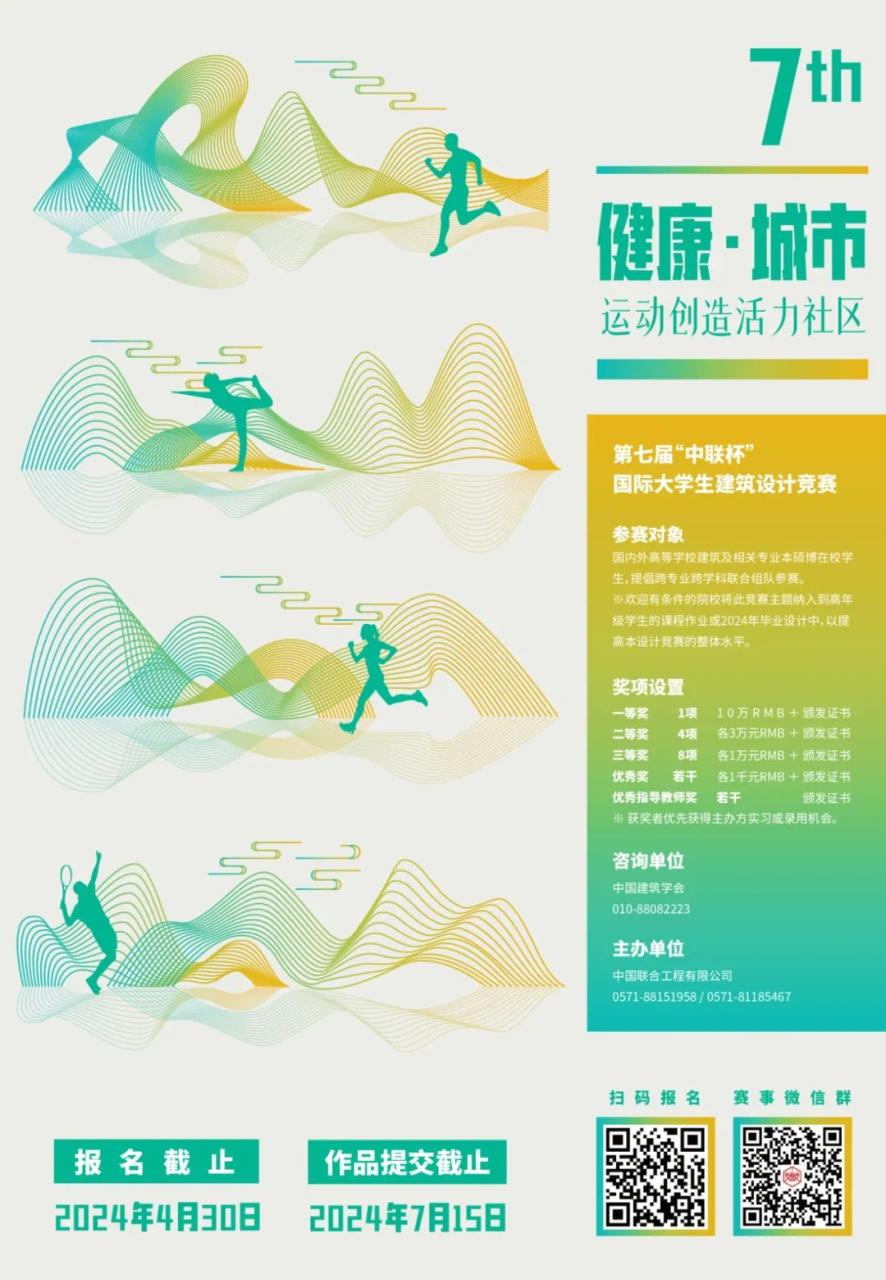健 康 · 城 市
——运动创造活力社区
Health · City
Sports Create Vibrant Communities
在全球化城市发展的趋势下,我们追求的不仅仅是城市的物理空间设计,更多的是对于城市生活、文化、生态、健康和未来的思考。在快速发展的城市中,人们期待一种健康的生活方式——活力城市,将健康、运动和社区紧密结合,为城市生活注入新的活力。
In the trend of globalized urban development, what we pursue is not only design for city physical space , but more about thinking of urban life, culture, ecology, health and future. In the rapidly developing cities, people expect a healthy lifestyle — dynamic cities, which closely intergrated health, sports and community to inject new vitality into urban life.
如今公园、绿道、运动场成为城市的新宠儿,绿色生态和运动设施的布局在快速的城市化进程中扮演着重要的角色,他们为居民提供了锻炼身体的良好环境。在为城市居民提供锻炼身体场所的基础上,促进了社区之间的互动和交流。
Nowadays, parks, green-trail and sports fields become new favorites in cities. The layout of green ecology and sports facilities plays an important role in the process of urbanization, They provide residents with a good environment for exercise..Promotes interaction and communication between communities on the basis of providing a place for urban residents to exercises.
然而,公共设施已经越来越不能满足人们不断变化的动机和行为。运动是否还能成为实现个人成就感和社会凝聚力的场所?当城市成为运动器材,在既定空间中,通过互动和设施,人们会定义出何种专属于自己的运动?如今虚拟体育元素的融入为运动提供了更加丰富的形式,在此背景下,运动是更加趋向于个人,还是反而带来了更多汇聚集体的机会?如何营造出满足不同年龄段不同阶层人群在不同时段运动健康需求的全域活力城市?
However, public facilities unable to satisfy people’s constant changing motivations and behaviors. Is it possible that sport can be a place for personal fulfillment and social conhesion? When the city becomes a sport equipment, in a given space, what kind of sports will people define for themselves? At present, the integration of virtual sports elements provides more abundant forms. In this circumstances, will the sport become more individual, or bring more opportunities for gathering? How can we create a holistic dynamic city that meets the health needs of people at all ages and classes at different times?
参赛者需根据城市特点,结合市民的休闲、运动和社交需求,充分利用城市公共空间,选取城市中可以激活公共活动的场所,打造满足现代人健康生活需求的活力中心。要求从多元复合功能设计、开放式公共空间、绿色环保理念、智能科技、艺术文化元素、社区参与、交通便利、灵活的空间规划、自然采光和通风以及人性化设计等方面的考虑,结合城市公共配套构筑物,为城市公共空间注入新的活力和意义,打造全时全龄全域的运动场所。Participants need to base on the city characteristics, related with citizen needs of leisure, sports and communication. fully utilize urban public space, select public urban places that can activate public events and create a vibrant center that meets the needs of modern people for healthy life. It is required to consider the following aspects: multi-functional design, open public space, eco-friendly concept, intelligent technology, artistic and cultural elements, community participation, convenient transportation, flexible spatial planning, natural lighting and ventilation, and humanized design. Associated with urban public facilities, the participants should provide urban public space with new vitality and meaning, and create a sports place for all ages and all regions.
参赛者需要提出具体的设计方案,包括空间/城市板块布局、设施配置、基础流线、活动策划等,以提升公共空间的使用率和吸引力或者是城市布局板块之间的联系。同时还要参赛者融入建筑学思考,既要打破城市中公共空间的边界,又要将运动设施真正地融入到活力社区的生活中。
Participants are expected to propose a specific design scheme, including spatial/urban block layout, facility configuration, infrastructure circulation, and event programming to enhance the utility and attractiveness of public space or the connections between urban blocks. Meanwhile, participants need to integrate architectural thinking, not only to break the boundaries of public spaces in the city, but also to truly integrate sports facilities into the life of dynamic communities.
设计要点
DESIGN ESSENTIALS
以“健康·城市”为创作主题,关注健康、休闲、社会纽带以及城市环境,探讨运动在未来社区生活中的深度融合,通过空间设计、设施配置、装置互动、活动策划等,重新定义运动空间,为城市公共空间注入新的活力和意义,构想未来城市生活的不同场景。
Taking “Health · City” as the theme, the competition focuses on health, leisure, social bonds and urban environment, and exploring the integration of sports in future community life. Redefining sports space through space design, facility configuration, device interaction, activity planning, etc., injecting new vitality and significance into urban public spaces, and envisioning different scenes of future urban life.
1.设计鼓励参赛者基于自己对健康与城市的理解,探讨二者之间的关系,用恰当的建筑语言表达前沿的、独特的、明晰的创作理念。
2.参赛者应对传统运动空间的制度、形式再定义,以敏锐的洞察力,准确发现、把握当前城市健康生活中的突出问题,结合全龄段市民的休闲、运动、社交和精神需求,提出富有创造力的解决方案。
3.鼓励参赛者将新的城市科学、城市感知技术、大数据、人工智能、虚拟现实、增强现实等技术手段运用于设计中,构建未来健康城市生活场景。
4.鼓励设计能够注重生态环境、运用合理的技术手段,注重节约能源。
1. Participants are encouraged to explore the relationship between health and city based on own understanding of “Health · City”, and to express cutting-edge, unique and clear creative ideas with appropriate architectural language.
2. Participants should redefine the form of traditional sports space, accurately discover and grasp the prominent problems in the current health city life with keen insight, and put forward creative solutions combining the leisure, sports, social and spiritual needs of citizens of all ages.
3. The participants are encouraged to apply new urban science, urban perception technology, data science, artificial intelligence, virtual reality, augmented reality and other techniques to the design, and build scenarios of future “Health · City” life.
4. The design is encouraged to pay attention to the ecological environmen and using reasonable techniques, and focus on energy saving.
PARTICIPANTS & REQUIREMENTS
1.全国及境外高等学校建筑及相关专业全日制在校学生(包括本科生和研究生),提倡跨专业跨学科联合组队参赛。
※欢迎各有关高校师生踊跃参加。如有条件的院校可将此竞赛主题,纳入到高年级学生的课程作业或2024年毕业设计中,以提高本设计竞赛的整体水平。
1.Full-time on-campus architecture and relevant major students from accredited institutions (including undergraduate and master) , encourage all participates team up with different disciplines.
2. All participants can participate alone or as a team of no more than four people.
3. Each group may have no more than 2 instructors.
※Teachers and students of relevant universities are welcomed. If qualified, institutions can incorporate this competition theme into senior students’ coursework or 2024 graduation design to improve the overall level of the design competition.
1.每项参赛作品提供2张竖向、A1规格(宽594mm×高841mm)参赛图纸,图纸需裱于轻质展板上,图面表达方式不限。
2.内容能充分表达作品创作意图的总平面图及建筑平、立、剖面图、效果图、分析图等,500字左右的设计说明(组合于图面之中)。
3.每个方案应同时提交参赛者简历(格式自拟)和设计方案电子资料(300dpi以上)一份,以光盘形式随展板一同提交。
4.每项参赛作品图板背面右下角应注明参赛方案名称、参赛者单位、姓名、电话、邮编等联系方式以及指导老师的名称,并用深色不透明纸密封。
※参赛作品提交后一律不退,请参赛人自留备份,版权归主办方所有。
1. 2 vertical A1 drawings (594mm wide x 841mm high) mounted on a light display board. There is no limit to the expression of the drawings.
2. The general plan and architectural elevation, profile, renderings, analysis drawing, etc. which can fully express the intention of the creation of the work are essential. And the design description of about 500 words (combined in the drawing) are also needed.
3. For each scheme, one copy of CV (in self-designed format) and electronic data of design scheme (above 300dpi) should be submitted together with the exhibition board in the form of CD-ROM.
4. In the lower right corner of the back of each entry board, the name of the entry scheme, the organization of the participant, his/her name, phone number, postal code and other contact information as well as the name of the instructor should be marked, and the information should be sealed with dark opaque paper.
※ Entries will not be returned after submission, please keep a copy. The copyright belongs to the organizer.
1. 参赛者同意并遵守本竞赛通知的内容及竞赛规则,违反规则者将被取消竞赛资格,竞赛组委会拥有此次竞赛的最终解释权;
2. 电子图纸中不得出现任何有关参赛者姓名和其所在院校的文字或图案,不符合规定者将被取消参赛资格;
3. 竞赛组织方拥有参赛作品署名权以外的其它版权权利,包括但不限于发行权,展览权,信息网络传播权,出版权等,参赛者具有署名权;
4. 禁止一稿多投,所有参赛者需确保自己所提交的作品为原创且未参加过其他竞赛。参赛作品不得包含任何侵犯第三方知识产权的行为,如发生侵权行为,组织单位不承担由此引发的任何连带责任;
5. 各小组提交一组参赛作品,严禁出现重复提交现象。如若发现同一作品出现重复提交情况,组委会有权选择其中一组进行评审;
6. 每位参赛者不能报名多组参赛,参赛小组及具体成员信息以最终提交文件为准;
1. Participants agree and abide by the content of the competition notice and the competition rules. Those who violate the rules will be disqualified from the competition.
2. The electronic drawing shall not contain any text or pattern related to the name of the participant and his/her institution. Those who do not meet the regulations will be disqualified from the competition;
3. The organizer of the competition shall have other copyright rights other than the right of authorship of the entries, including but not limited to the right of distribution, exhibition, information network communication, publishing, etc. Participants shall have the right of authorship;
4. All participants must ensure that their submissions are original and have not participated in other competitions. The entries shall not contain any infringement of the intellectual property rights of the third party. In case of infringement, the organization shall not bear any joint and several liability arising therefrom;
5. Each team shall submit one group of entries. Repeat submission is strictly prohibited. If the same work is found to be submitted repeatedly, the Organizing committee has the right to select one group for review;
6. Each participant cannot register for more than one group. The information of the group and its members shall be subject to the final submission documents;
7. The judges of this competition shall not serve as the instructor of the team.
※ 获奖作品由主办方颁发奖金和获奖证书,以上奖金均含税,所有获奖的学生通过面试后均可优先获得主办方实习或录用机会。
Certificate and 100,000 RMB (before tax);
Certificate and 30,000 RMB (before tax);
Certificate and 10,000 RMB (before tax);
Honorable mentions (several teams)
Certificate and 1,000 RMB (before tax);
Advisors of prize-winning projects will also be awarded with certificates.
※ Prize money and award certificate will be awarded by the organizer. The prize money mentioned above includes tax. All the winning students will have priority to get internship or employment opportunities in CUC after passing the interview.

1. Registration deadline: April 30, 2024
Scan the QR code or click to read the original text to complete the registration.
2.作品提交截止时间:2024年7月15日
参赛作品具体提交方式及地址,详见后续通知。
Submission deadline: July 15, 2024
Please refer to the subsequent notice for the specific submission method and address of the entries.
※ 欢迎各大高校以院系为单位或以个人、小组为单位的方式进行报名。参赛人必须按本通知时间要求填写参赛报名回执表,报名后应按时提交参赛方案。本次竞赛免交报名费。
※ All colleges and universities are welcome to apply by department or by individual or group. Participants must fill in the registration form and send it to the designated email address according to the notification time, and submit the competition plan on time after registration. There is no entry fee for this competition.
第六届“中联杯”国际大学生建筑设计竞赛评选委员会由何镜堂、修龙、程泰宁、刘景樑、刘加平、孟建民、韩光宗、唐玉恩、张宇、陈雄、张利、孔宇航、李翔宁、仲德崑、魏春雨、王绍森等业内著名专家组成,何镜堂院士任评选委员会主任。
The selection committee of the 6th “CUC Cup” International College Student Architecture Design Competition is composed of renowned experts in the industry, including He Jingtang, Xiu Long, Cheng Taining, Liu Jingliang, Liu Jiaping, Meng Jianmin, Han Guangzong, Tang Yuen, Zhang Yu, Chen Xiong, Zhang Li, Kong Yuhang, Li Xiangning, Zhong Dekun, Wei Chunyu, Wang Shaosen, etc. Academician He Jingtang serves as the director of the selection committee.
邮箱:lengliang@chinaasc.org.cn
网址:http://zlb.chinaasc.org.cn
The Architectural Society of China
Contact person: Leng Liang
Phone: 010-88082223
Email: lengliang@chinaasc.org
Website: http://zlb.chinaasc.org.cn
电话:0571-88151958 / 0571-81185467
网址:http://www.chinacuc.com/
China United Engineering Co., Ltd
Contact person: Shen Xiang/Wang Jingyi
Phone: 0571-88151958/87379460
Fax: 0571-88138062
Post: cucup@chinacuc.com
Address: Human Resources Department, No. 1060 Bin’an Road, Binjiang District, Hangzhou City
Postal Code: 310052
Website: http://www.chinacuc.com/




